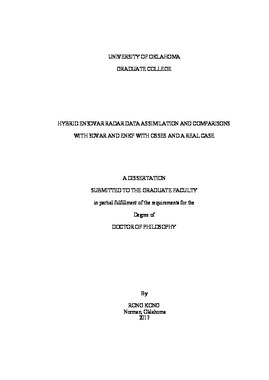| dc.description.abstract | Studies have shown advantages of the hybrid ensemble-variational data assimilation (DA) algorithms over pure ensemble or variational algorithms, although such advantages at the convective scale, in the presence of complex ice microphysics and for radar data assimilation, have not yet been clearly demonstrated, if the advantages do exist. A hybrid ensemble-3DVar (En3DVar) system is developed recently based on the ARPS 3DVar and EnKF systems at the Center for Analysis and Prediction of Storms (CAPS). In this dissertation, hybrid En3DVar is compared with 3DVar, EnKF, and pure En3DVar for radar DA through observing system simulation experiments (OSSEs) under both perfect and imperfect model assumptions. It is also applied to a real case including multiple tornadic supercells. For the real case, radar radial velocity and reflectivity data are assimilated every 5 minutes for 1 hour that is followed by short-term forecasts. DfEnKF that updates a single deterministic background forecast using the EnKF updating algorithm is introduced to have an algorithm-wise parallel comparison between EnKF and pure En3DVar.
In the perfect-model OSSEs, DfEnKF and pure En3DVar are compared and are found to perform differently when using the same localization radii. The serial (EnKF) versus global (pure En3DVar) nature of the algorithms, and direct filter update (EnKF) versus variational minimization (En3DVar) are the major reasons for the differences. Hybrid En3DVar for radar DA is also compared with 3DVar, EnKF, DfEnKF, and pure En3DVar. Experiments are conducted first to obtain the optimal configurations for different algorithms before they are compared; the optimal configurations include the optimal background decorrelation scales for 3DVar, optimal localization radii for EnKF, DfEnKF, and pure En3DVar, as well as the optimal hybrid weights for hybrid En3DVar. When the algorithms are tuned optimally, hybrid En3DVar does not outperform EnKF or pure En3DVar, although their analyses are all much better than 3DVar. When ensemble background error covariance is a good estimation of the true error distribution, pure ensemble-based DA methods can do a good job, and the advantage of including static background error covariance B in hybrid DA is not obvious.
In the imperfect-model OSSEs, model errors are introduced by using different microphysical schemes in the truth run (Lin scheme) and in the ensemble forecasts (WSM6 scheme). Experiments are conducted to obtain the optimal configurations for different algorithms, similar to those in perfect-model OSSEs. Hybrid En3DVar is then found to outperform EnKF and pure En3DVar (3DVar) for better capturing the hail analyses below the freezing level (intensity of the storm). The advantage of hybrid En3DVar over pure ensemble-based methods is most obvious when ensemble background errors are systematically underestimated. In addition, the impact of adding a mass continuity constraint in 3DVar, pure and hybrid En3DVar is also examined. Overall, adding the mass continuity constraint improving the analyses by producing a little stronger vertical velocity analyses that are much closer to the truth and by smoothing noise present in the velocity and hydrometer fields.
Finally, the ARPS hybrid En3DVar system is applied to the assimilation of radar data for a real tornadic supercell storm. Hybrid En3DVar is compared with 3DVar, EnKF, DfEnKF, and pure En3DVar based on both objective verification and the analyses and forecasts of storm intensity and structures. Hybrid En3DVar with 75% weight of static B clearly outperforms 3DVar in better capturing the hook echo structure and rotating updraft in the forecasts, and outperforms EnKF and DfEnKF in better capturing forecast reflectivity between 35 and 45 dBZ. The low-level mesocyclone is better forecast by hybrid En3DVar than by other methods, suggesting stronger rotations and a larger tornado threat in the forecast.
In perfect-model OSSEs, only precipitation reflectivity (≥ 5 dBZ) is assimilated. In the imperfect-model OSSEs and the real data case, the clear-air reflectivity (< 5 dBZ) is also assimilated to help suppress spurious storms. The assimilation of clear-air reflectivity by the variational DA algorithms is found to seriously degrade the analyses in storm region, with the intensity of the reflectivity analysis being much weaker than that assimilating reflectivity larger than 5 dBZ only. When using hydrometeor mixing ratios as the control variables, the gradient of the cost function becomes extremely large when background reflectivity is small. In the imperfect-model OSSEs, a double-pass procedure is proposed and found to help alleviate this problem. In the real data case, an alternative way of using the logarithmic hydrometeor mixing ratios as the control variables is found to be a better solution to the problem. In such a case, the excessively large gradient of the cost function is avoided. | en_US |
